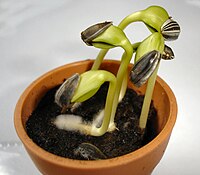
Photo from wikipedia
Seed germination is a key transitional stage in plant life cycle and is strongly regulated by temperature and light. Therefore, research on the effects of temperature and light on seed… Click to show full abstract
Seed germination is a key transitional stage in plant life cycle and is strongly regulated by temperature and light. Therefore, research on the effects of temperature and light on seed germination is extremely meaningful for vegetation restoration, especially in desert ecosystems. Seeds of 28 ephemeral plants collected from the Gurbantunggut Desert of China were incubated at different temperatures (5°C/1°C, 15°C/5°C, 20°C/5°C, 25°C/10°C and 30°C/15°Q in 12-h light/12-h darkness or continuous darkness regimes, and the responses of seed germination to temperature and light and the germination speed were studied in 2016. Results showed that seed germination percentage of the 28 ephemeral plants significantly differed to temperature and light. We classified the studied plants as the following groups based on their responses to temperature: 1 low temperature responsed plants, 12 moderate temperature responsed plants, 7 high temperature responsed plants, 4 non-responsed plants and 5 plants of no germination. It should be noted that Corispermum lehmannianum Bunge is sensitive to moderate and high temperatures. There were 4 groups of plant in response to light, i.e., 7 light responsed plants, 10 dark responsed plants, 6 light non-responsed plants and 5 plants of no germination. Based on seed germination speed of the 28 ephemeral plants, we divided them into 4 patterns of germination, i.e., very rapid, moderately rapid, moderate and slow. Combining variations of temperature, precipitation and sand dune types in the study area, we suggested that very rapid and moderately rapid germinated plants could be used to moving sand dunes in early spring during vegetation restoration, moderate germinated plants could be used to semi-fixed sand dunes in late autumn, and slow germinated plants could be used to sand plain in summer. Thus, seedling establishment and vegetation restoration would be improved by considering seed germination characteristics of these ephemeral plants in the Gurbantunggut Desert, China.
Journal Title: Journal of Arid Land
Year Published: 2019
Link to full text (if available)
Share on Social Media: Sign Up to like & get
recommendations!